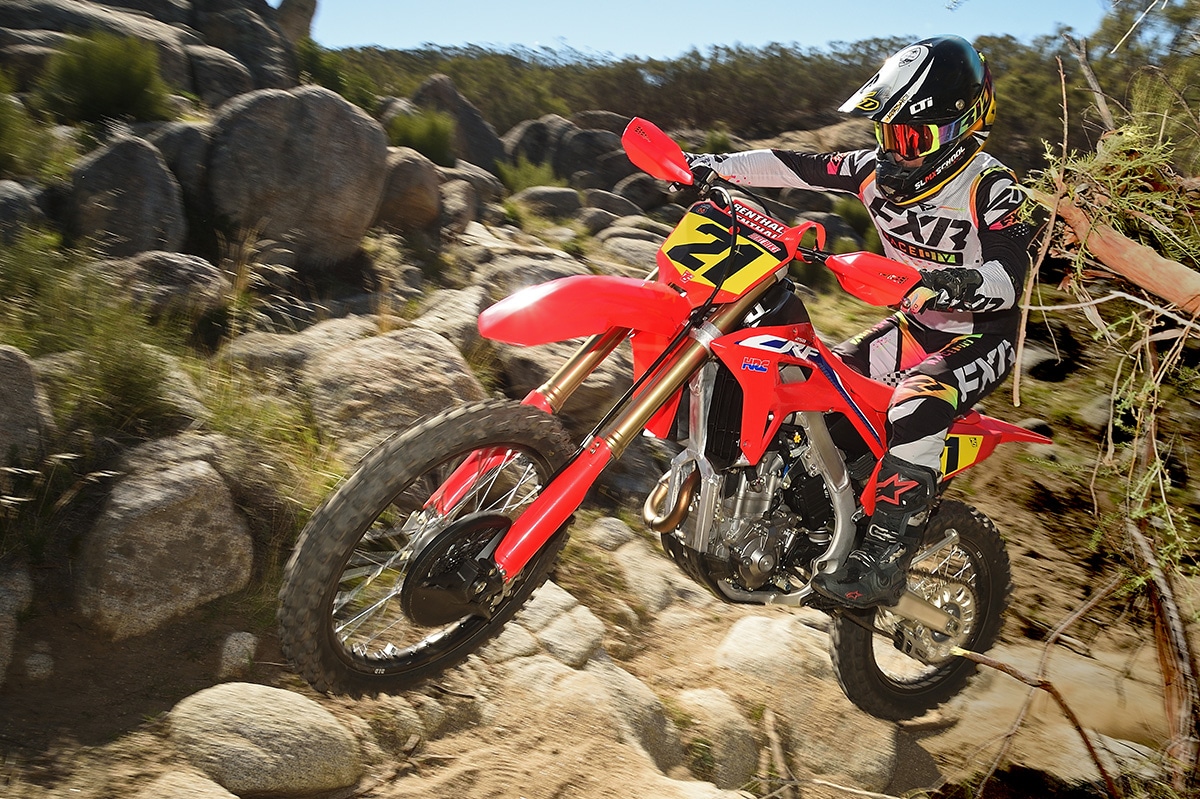The Honda CRF250RX is now in its second generation, and we have one in our dirty hands. The first version kinda had bad timing. Back in 2016, Trevor Bollinger won the GNCC XC2 championship on the SOHC CRF250R motocross bike, which we tested, and it was awesome. That bike would have made a great platform for a production off-road bike. Sadly, the RX didn’t show up until 2019, which was after the Honda 250 MX bike was completely and totally redesigned. The torquey single-cam motor was traded in for a DOHC screamer. Like I said, bad timing.

The 2022 version is a different story. Honda redesigned it with weight loss and increased low-end power as the primary objectives. The chassis is the same layout that was introduced in 2021 on the CRF450R and RX. That means the wheelbase is shorter, the steering head angle is more relaxed and the subframe is lighter. The airbox is completely different with 78 percent greater air volume. The twice pipes are gone and the new head has a straighter exhaust port leading to a single headpipe. The clutch now has nine plates instead of eight, there’s an additional friction spring, the basket is new and there are about a dozen other changes.
All of that stuff is identical to the new CRF250R motocross bike. For off-road, the RX got a larger fuel tank, softer suspension, different mapping (for all three maps), an 18-inch rear wheel (with Dunlop AT81 tires), a kickstand and handguards. It has the same muffler and gear ratios as the MX version. All together, the off-road stuff adds 8 pounds to the package. The 2022 CRF250RX weighs 228 pounds without fuel on the official Dirt Bike digital scale. Last year’s model was 235 pounds on the same scale.
The original version of the RX was better than it should have been. It was weak off the bottom, but we liked it because the delivery was smooth, the suspension was good and the overall handling was great. The new version is an improvement in every way. First, the power starts lower and has something of a hit in the mid-range. It still has a ton of top, although Honda clearly traded away some of that for torque. On tight trails you can stay in second or third gear for long stretches without shifting. Of all the 250 four-strokes currently available, the new Honda has the most low-end power. That’s a big reversal of fortune. Interestingly, most riders say they like the Honda’s most aggressive map the best. That’s the one signified by three flashes of the blue light. The other two maps are the same down low, but with less top end–no real gain anywhere. The jury is still out with traction control. At times, it helps on level ground, but no one cares for the way it feels on loose hills.

Honda reworked the suspension settings extensively for the new bike. The RX has the same fork as the MX bike, but with softer springs and different valving. Most riders love it. In one week, I went from rocky desert canyons to a round of the National Grand Prix Championship at Taft. The fork just needed a few clicks of compression damping and it was fine. The rear end, on the other hand, was great in the rocks, but too soft for the grand prix. I would like to hold on to this bike for a few more GPs, but Honda might want it back a little too soon. Either way, a full test will appear in the May print issue of Dirt Bike.
RUSSIA, UKRAINE AND URAL
The conflict in Ukraine seems far away, but it’s in the faces of our friends at Ural every day. They sent this message on Thursday.
Dear Friends,
We wish we wouldn’t have to update you under the circumstances we find ourselves in.
Questions and concerns inevitably come up about possible sanctions, availability of bikes and parts, support and so on. The short answer is that we are as ready as we can possibly be to address whatever challenges may come our way. Over the years we’ve learned to navigate ups and downs, to make plans B, C and D both strategically and on the fly. We’ve weathered storms that were very real and dealt with obstacles that were not so publicly known. The history of our brand shows that Ural always finds a way to move forward. Our highest priorities have always been our employees, our partners and our customers. We still hope for people to remain human, value life and stand for living instead of fighting.
We pray for peace.
The Team at Ural
HUSKY VIDEO SERIES
In this first episode of Grit and Grind, we go behind the scenes with Rockstar Energy Husqvarna Factory Racing’s latest signing Malcolm Stewart as he takes on the first few rounds of the 2022 AMA Supercross series. From training at Baker’s Factory to the excitement of race day, our cameras have an all-access pass to follow Malcolm through the highs and lows in never-seen-before exclusive footage. Grit and Grind is a docuseries collaboration between Husqvarna Motorcycles North America and Rockstar Energy, giving viewers a immersive look behind the scenes with the five-racer squad over 17 rounds of the AMA Supercross Championship, and the personalities that make up the dynamic team.
HARE AND HOUND
WORCS VIDEO SERIES
We got to attend last week’s round of the WORCS series at Glen Helen, and they had a great track. Here’s there on-going Dirt Diaries video series covering that round.
BACK IN THE DAY: DEANZA CYCLE PARK
Through the late ’70s when I was in college, I covered races at DeAnza Cycle Park for various publications and sold photos to the riders ($2 for a B&W 8×10). I still run across photos in old boxes. Here’s Gregg Toyama leading Brian Myerscough in 1977 (or thereabouts). This was probably one of MVMC’s $600 purse weekends. Don’t remember who won. Gregg didn’t show up that often, but Brian was fairly regular because he lived in Calimesa, about 15 miles away. He called it “DeathAnza,” but I think he loved it. I did too.
See you next time!
–Ron Lawson








Comments are closed.